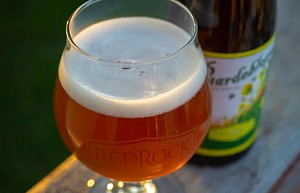Relax and enjoy Paardebloem at a Red Rock brewpub while supplies last.The 2021 vintage of Paardebloem is a blend of 75% aged and 25% fresh beer, compared to the 50/50 ratio of previous years. This proportion gives the beer a stronger chardonnay character, a bit more tartness, and extra complexity in the aroma.
Look for peppery, floral, grassy notes, sweet cherry, stone fruit, and pineapple, with a hint of amaretto and toffee and a dry, oaky finish. The wild yeast lends a light funkiness, with highlights of peaches and pears. Flavors are delicate, yet robust. This may be our favorite Paardebloem to date!
Very limited quantities of 500mL and 750 mL bottles will be available for sale at the Red Rock Beer Store. Limit of (2) bottles per customer.
What is in a bottle of Paardebloem?Choice ingredients, attention to detail, time – these things seem evident, but how does it all come together?
We start with Weyermann Pilsner malt hand-toasted in Red Rock’s wood-burning pizza ovens. The golden-brown grain is milled and mashed, the sweet liquid extracted and ready for the boil. As the wort bubbles, brewers add peaches to give the beer juicy, fruit notes. Grains of paradise give it a pop of pepper and licorice. Fresh dandelion greens, collected in mesh bags, go into the boil in place of hops to provide the needed bittering element to the beer. This is where Paardebloem, Dutch for “dandelion”, gets its name!
Once the beer is happily settled in first-fill chardonnay barrels, it gets inoculated with our in-house propagated Brettanomyces Lambicus, a strain of wild yeast found in Belgian Lambic beers that produces cherry flavors, sourness, and classic funky, barnyard “Brett” characteristics. After spending a full year quietly aging, the beer is tasted and blended with freshly brewed Paardebloem to achieve the final, delicious product.
When Paardebloem is perfectly aged and blended, brewers add priming sugar and Champagne yeast, then bottles are meticulously hand-filled and capped. As the new yeast consumes the sugars inside the bottle, CO2 is created, carbonating the beer. When it is light and fizzy like Prosecco, it is ready to drink!
Bottles are labeled, hand-dipped in wax and boxed up for distribution.
Share:Original Source Here

